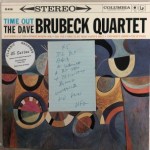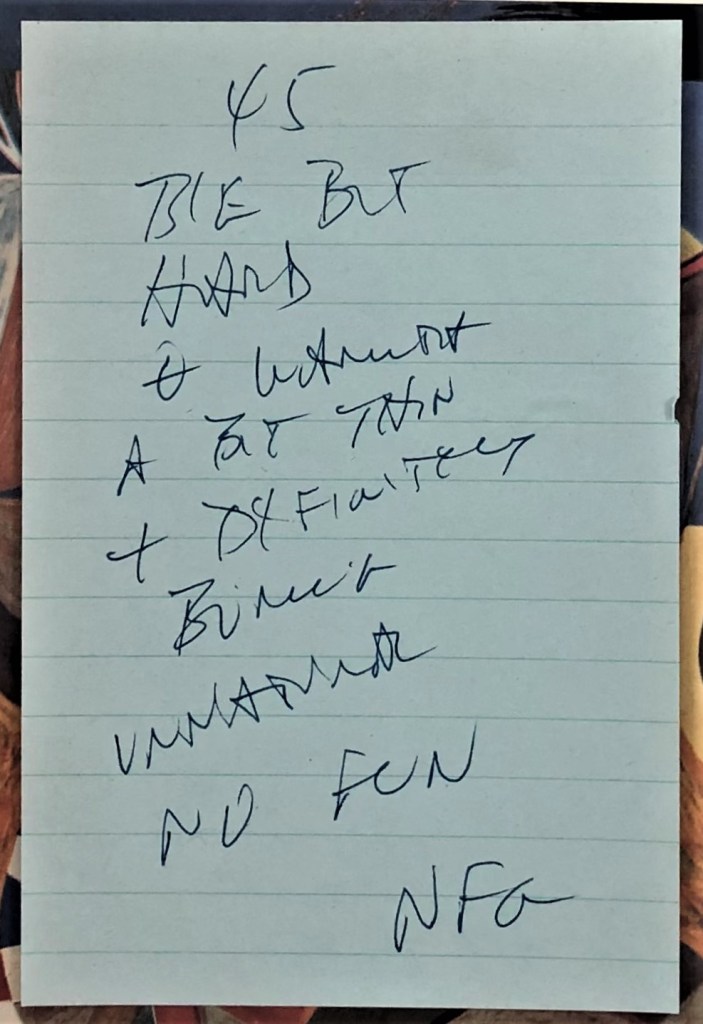 More of the Music of Dave Brubeck
More of the Music of Dave Brubeck
Reviews and Commentaries for Time Out
Sonic Grade: F
An Audiophile Hall of Shame pressing and another Classic Records Jazz LP.
Not long ago we found a single disc from the 45 RPM four disc set that Classic Records released in 2002 and decided to give it a listen as part of our shootout for the album.
My notes can be seen below, but for those who have trouble reading my handwriting, here they are:
- Big but hard
- Zero (0) warmth
- A bit thin and definitely boring
- Unnatural
- No fun
- No F***ing Good (NFG)
 Does that sound like a record you would enjoy playing? I sure didn’t.
Does that sound like a record you would enjoy playing? I sure didn’t.
But this is the kind of sound that Bernie Grundman managed to find on Classic Record after Classic Record starting in the mid-90s when he began cutting for them.
We’ve been complaining about the sound of these records for more than twenty years but a great many audiophiles and the reviewers who write for them told us we wrong. If you have a copy of this album on Classic, at 33 or 45, play it and see if you don’t hear the problems we ascribe to it.
To see what we had to say about the 33 RPM version on Classic many years ago, click here.
Maybe we got a bad 45 and the others are better. That has not been our experience.
In these four words we can describe the sound of the average Classic Records pressing.
Not all of their records are as bad sounding as Time Out. We favorably review some of the better ones here.
A Must Own Jazz Record
We consider Time Out a Masterpiece. It’s a recording that should be part of any serious Jazz Collection. Others that belong in that category can be found here.
What the Best Sides of Time Out Have to Offer Is Not Hard to Hear
- The biggest, most immediate staging in the largest acoustic space
- The most Tubey Magic, without which you have almost nothing. CDs give you clean and clear. Only the best vintage vinyl pressings offer the kind of Tubey Magic that was on the tapes in 1959
- Tight, note-like, rich, full-bodied bass, with the correct amount of weight down low
- Natural tonality in the midrange — with all the instruments having the correct timbre
- Transparency and resolution, critical to hearing into the three-dimensional studio space
What We’re Listening For on Time Out
- Energy for starters. What could be more important than the life of the music?
- The Big Sound comes next — wall to wall, lots of depth, huge space, three-dimensionality, all that sort of thing.
- Then transient information — fast, clear, sharp attacks, not the smear and thickness so common to these LPs.
- Tight punchy bass — which ties in with good transient information, also the issue of frequency extension further down.
- Next: transparency — the quality that allows you to hear deep into the soundfield, showing you the space and air around all the instruments.
- Extend the top and bottom and voila, you have The Real Thing — an honest to goodness Hot Stamper.
TRACK LISTING
Side One
Blue Rondo A La Turk
Strange Meadow Lark
Take Five
Side Two
Three To Get Ready
Kathy’s Waltz
Everybody’s Jumpin’
Pick Up Sticks
AMG 5 Star Rave Review
Dave Brubeck’s defining masterpiece, Time Out is one of the most rhythmically innovative albums in jazz history, the first to consciously explore time signatures outside of the standard 4/4 beat or 3/4 waltz time. It was a risky move — Brubeck’s record company wasn’t keen on releasing such an arty project, and many critics initially roasted him for tampering with jazz’s rhythmic foundation.
But for once, public taste was more advanced than that of the critics. Buoyed by a hit single in altoist Paul Desmond’s ubiquitous “Take Five,” Time Out became an unexpectedly huge success, and still ranks as one of the most popular jazz albums ever. That’s a testament to Brubeck and Desmond’s abilities as composers, because Time Out is full of challenges both subtle and overt — it’s just that they’re not jarring.
Brubeck’s classic “Blue Rondo à la Turk” blends jazz with classical form and Turkish folk rhythms, while “Take Five,” despite its overexposure, really is a masterpiece; listen to how well Desmond’s solo phrasing fits the 5/4 meter, and how much Joe Morello’s drum solo bends time without getting lost. The other selections are richly melodic as well, and even when the meters are even, the group sets up shifting polyrhythmic counterpoints that nod to African and Eastern musics.
Some have come to disdain Time Out as its become increasingly synonymous with upscale coffeehouse ambience, but as someone once said of Shakespeare, it’s really very good in spite of the people who like it. It doesn’t just sound sophisticated — it really is sophisticated music, which lends itself to cerebral appreciation, yet never stops swinging. Countless other musicians built on its pioneering experiments, yet it’s amazingly accessible for all its advanced thinking, a rare feat in any art form.
This belongs in even the most rudimentary jazz collection.
FURTHER READING
Here are some of our reviews and commentaries concerning the many Heavy Vinyl pressings we’ve played over the years, well over 200 at this stage of the game. Feel free to pick your poison.
And finally,
A Confession
One final note of honesty. Even as recently as the early 2000s we were still somewhat impressed with many of the better Heavy Vinyl pressings. If we had never made the progress we’ve worked so hard to make over the course of the last twenty plus years perhaps we would find more merit in the Heavy Vinyl reissues so many audiophiles seem to prefer.
We’ll never know of course; that’s a bell that can be unrung. We did the work, we can’t undo it, and the system that resulted from it is merciless in revealing the truth — that these newer pressings are second-rate at best and much more often than not third-rate or worse.
Setting higher standards — no, being able to set higher standards — in our minds is a clear mark of progress. We know that many of our customers see things the same way.